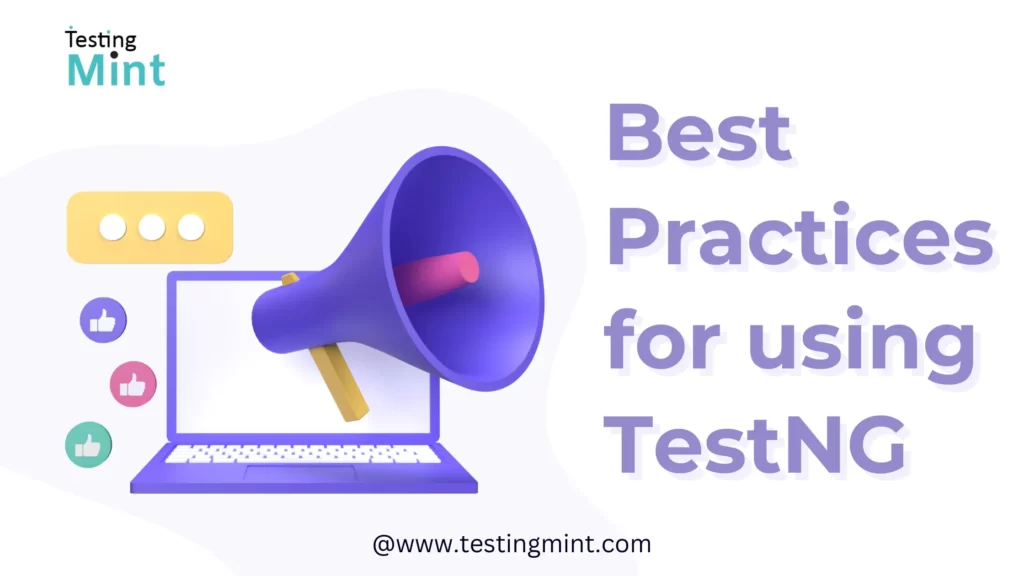When it comes to automating web testing with Selenium WebDriver and TestNG, there are certain best practices that can help us achieve better results. By following these practices, we can improve the reliability, maintainability, and scalability of our tests. In this blog, we will discuss some of the best practices for using TestNG with Selenium WebDriver.
Best Practices for using TestNG
There are several best practices that can help us write effective and efficient TestNG tests with Selenium WebDriver. Following are some of the best practices:
1. Use a Page Object Model (POM)
The Page Object Model is a design pattern that helps us organize our test code by separating the web page elements from the test code. By using POM, we can create a class for each web page in our application, and define the page elements as fields and methods in that class. This allows us to reuse the page elements in multiple tests and maintain the test code more easily.
Here is an example of a page object for a login page:
public class LoginPage {
private WebDriver driver;
@FindBy(id = "username")
private WebElement usernameField;
@FindBy(id = "password")
private WebElement passwordField;
@FindBy(id = "login-button")
private WebElement loginButton;
public LoginPage(WebDriver driver) {
this.driver = driver;
}
public void enterUsername(String username) {
usernameField.sendKeys(username);
}
public void enterPassword(String password) {
passwordField.sendKeys(password);
}
public void clickLoginButton() {
loginButton.click();
}
}
By using POM, we can create a more modular and maintainable test code that is easier to understand and update.
2. Use Test Data Providers
Test data providers are a feature of TestNG that allows us to pass different sets of test data to our tests. By using test data providers, we can write a single test method and run it with different sets of test data, which can save us time and effort.
Here is an example of a test data provider for a login test:
@DataProvider(name = "login-data")
public Object[][] loginData() {
return new Object[][] {
{"user1", "password1"},
{"user2", "password2"},
{"user3", "password3"}
};
}
By using test data providers, we can write a single test method that takes the username and password as parameters, and run it with different sets of test data.
3. Use Meaningful Test Method Names
Test method names should be descriptive and meaningful so that anyone reading the test code can understand what the test is doing. By using meaningful test method names, we can make our test code more readable and maintainable.
Here is an example of a meaningful test method name:
@Test
public void testLoginWithValidCredentials() {
// test code here
}
By using meaningful test method names, we can make our test code more understandable and maintainable.
4. Use Assertions
Assertions are a feature of TestNG that allows us to check whether a condition is true or false. By using assertions, we can verify that our test code is working as expected, and detect any issues or errors in the test code.
Here is an example of an assertion for a login test:
@Test
public void testLoginWithValidCredentials() {
LoginPage loginPage = new LoginPage(driver);
loginPage.enterUsername("user1");
loginPage.enterPassword("password1");
loginPage.clickLoginButton();
assertTrue(driver.getCurrentUrl().contains("dashboard"));
}
By using assertions, we can ensure that our test code is working correctly and catch any errors or issues in the test code.
5. Use Before and After Annotations
TestNG provides several annotations that allow us to execute setup and closedown code before and after each test method. By using these annotations, we can ensure that our test environment is set up correctly before each test, and cleaned up after each test.
Here is an example of using Before and After annotations:
public class LoginTest {
private WebDriver driver;
@BeforeMethod
public void setUp() {
driver = new ChromeDriver();
driver.get("https://www.example.com/login");
}
@Test
public void testLoginWithValidCredentials() {
LoginPage loginPage = new LoginPage(driver);
loginPage.enterUsername("user1");
loginPage.enterPassword("password1");
loginPage.clickLoginButton();
assertTrue(driver.getCurrentUrl().contains("dashboard"));
}
@AfterMethod
public void tearDown() {
driver.quit();
}
}
By using Before and After annotations, we can ensure that our test environment is set up correctly before each test, and cleaned up after each test.
6. Use Grouping
TestNG provides a feature called grouping, which allows us to group our tests by category or feature. By using grouping, we can run specific groups of tests, or exclude specific groups of tests, which can save us time and effort.
Here is an example of using grouping:
public class LoginTest {
@Test(groups = { "smoke", "login" })
public void testLoginWithValidCredentials() {
// test code here
}
@Test(groups = { "regression", "login" })
public void testLoginWithInvalidCredentials() {
// test code here
}
}
By using grouping, we can run specific groups of tests, such as smoke tests or regression tests, or exclude specific groups of tests, such as tests that are known to be unstable or unreliable.
Conclusion
In conclusion, by following these best practices, we can create more effective and efficient TestNG tests with Selenium WebDriver. By using a Page Object Model, test data providers, meaningful test method names, assertions, Before and After annotations, and grouping, we can create more robust and maintainable tests that can help us ensure the quality of our web applications.
You Might Like:
- TestNG Reporting with Selenium WebDriver
- TestNG and Selenium
- XPath in Selenium
- Assertions in Selenium
- How to Handle Dropdown in Selenium
- Waits in Selenium: Implicit, Explicit, and Fluent
- How to Handle Alerts and Popups in Selenium
- Web Locators In Selenium
- WebElement In Selenium
- How to Automate Drag and Drop in Selenium

